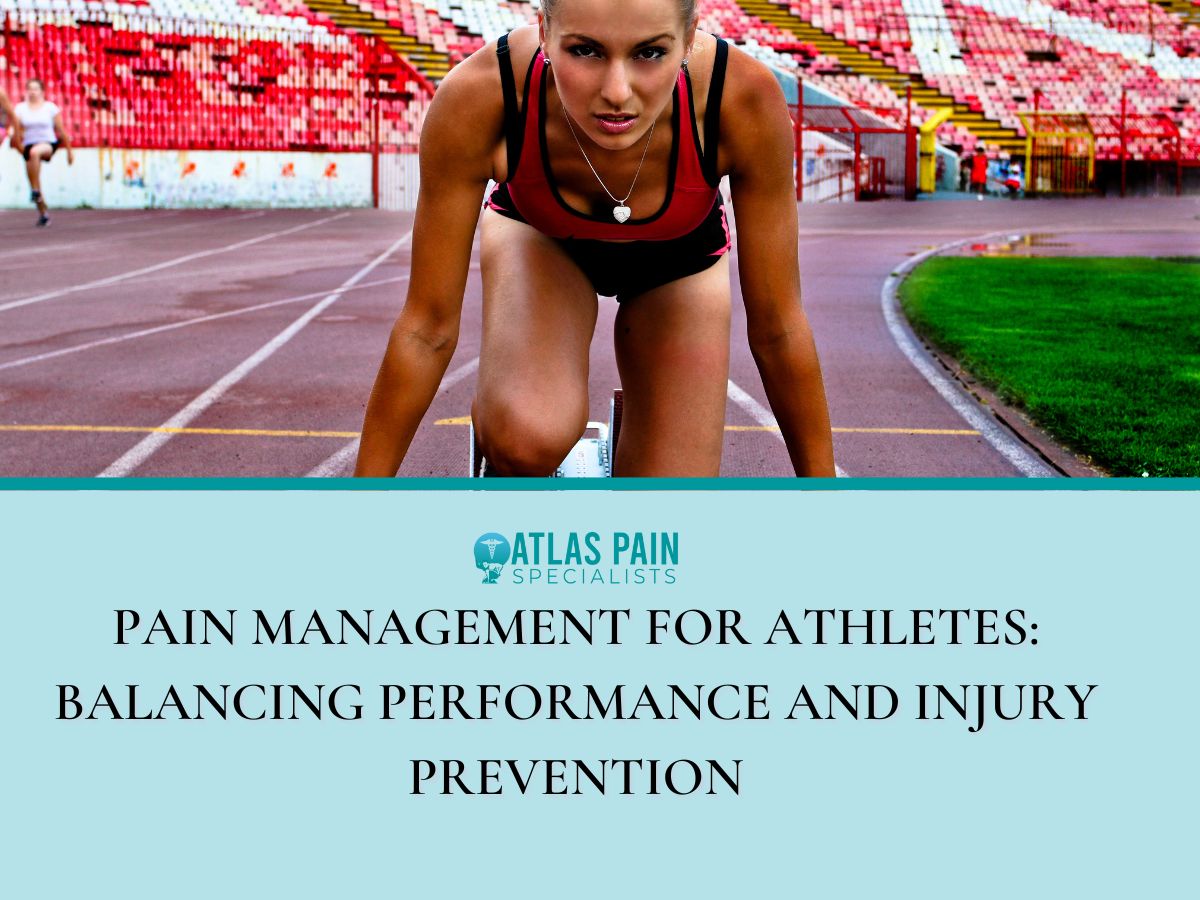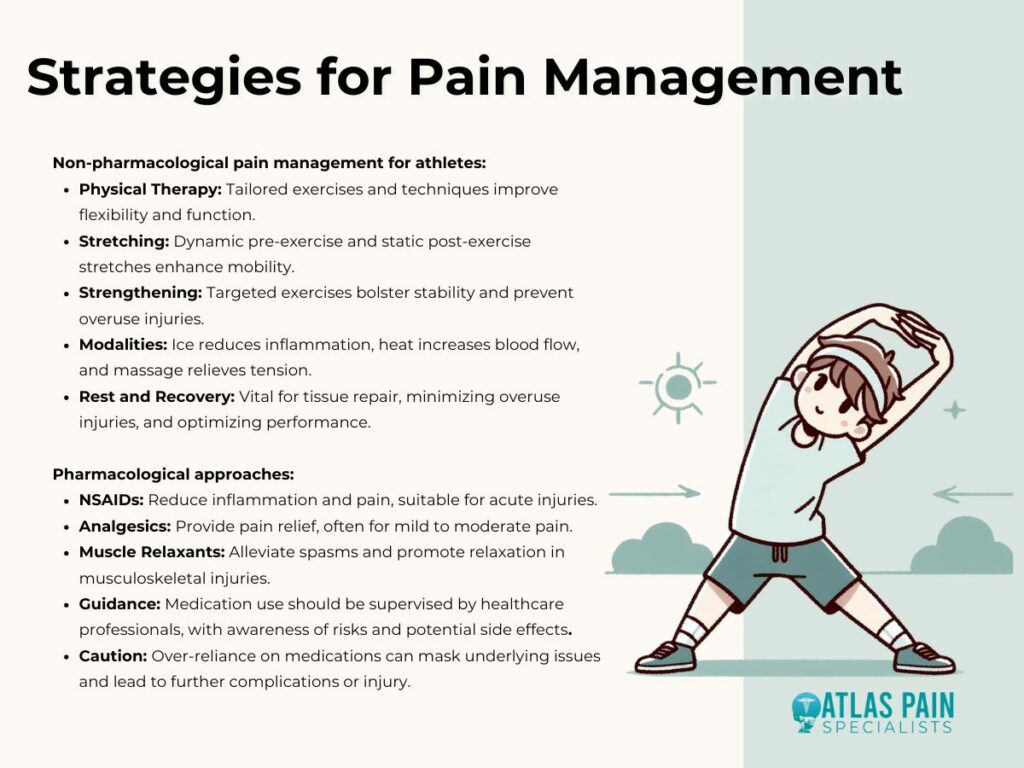

Pain Management for Athletes: Balancing Performance and Injury Prevention
Effective pain management is paramount for athletes striving for peak performance while minimizing the risk of injury. Understanding the complexities of pain perception, its impact on athletic performance, and implementing comprehensive strategies is vital.
This necessitates a holistic approach encompassing non-pharmacological interventions, training modifications, nutritional considerations, and mental health support. In this blog we will talk about pain management for athletes.
Understanding Pain in Athletes
Understanding pain in athletes involves distinguishing between acute and chronic pain and recognizing their respective durations, causes, symptoms, and management approaches. Below are ways of differentiating between acute and chronic pain in athletes:
| Criteria | Acute Pain | Chronic Pain |
| Duration | Typically, short-term, sudden-onset | Persistent, lasting beyond injury |
| Cause | Often due to recent injury or trauma | Can result from prolonged overuse |
| Symptoms | Sharp, localized pain | Dull, persistent discomfort |
| Management Approach | Focus on immediate relief and healing | Requires comprehensive treatment plan |
Exploring common causes of pain in athletes
Pain is a prevalent issue among athletes, often stemming from various factors related to their rigorous training and competition schedules. Below are the common causes of pain in athletes:
- Overuse injuries: Result from repetitive stress on muscles, tendons, and joints.
- Traumatic injuries: Sudden impacts or accidents during sports activities.
- Poor biomechanics: Incorrect movement patterns leading to strain and injury.
- Muscle imbalances: Weakness or tightness in certain muscle groups predisposing athletes to pain.
- Inadequate rest and recovery: Insufficient time for the body to repair and regenerate tissues.
Impact of pain on athletic performance and overall well-being
Pain not only affects an athlete's physical performance but also has significant implications for their mental and emotional well-being. Below are the impact of pain on athletic performance and overall well-being:
- Reduced performance: Pain can impair movement, agility, and strength, limiting an athlete's ability to perform at their peak.
- Psychological effects: Chronic pain can lead to frustration, anxiety, and depression, impacting motivation and confidence.
- Quality of life: Persistent pain can interfere with daily activities and diminish overall enjoyment of life.
- Risk of further injury: Ignoring pain or overcompensating for it can increase the likelihood of sustaining additional injuries.
- Disruption of training and competition: Pain may necessitate breaks in training or withdrawal from competitions, affecting long-term goals and aspirations.
Strategies for Pain Management
Non-pharmacological approaches are essential in managing pain among athletes, focusing on techniques like physical therapy, stretching, and modalities such as ice and heat therapy.

Non-Pharmacological Approaches
Non-pharmacological approaches play a pivotal role in managing pain effectively among athletes. One of the primary methods is physical therapy, which involves targeted exercises and techniques to improve flexibility, strength, and overall function.
Physical therapists work closely with athletes to develop personalized rehabilitation programs that address the underlying causes of pain and promote healing. Through a combination of therapeutic exercises, manual therapy, and modalities such as ultrasound or electrical stimulation, physical therapy aims to alleviate pain, restore mobility, and prevent future injuries.
Stretching and strengthening exercises are essential components of any pain management regimen for athletes. Stretching helps improve flexibility and range of motion, reducing muscle tension and the risk of strain or injury. Dynamic stretching before exercise and static stretching after can help athletes prepare their bodies for physical activity and aid in recovery post-workout.
Strengthening exercises, on the other hand, target specific muscle groups to enhance stability and support around joints, reducing the likelihood of pain and dysfunction. Incorporating exercises that focus on core strength, balance, and proprioception can help athletes maintain proper biomechanics and prevent overuse injuries.
Modalities such as ice, heat, and massage therapy are commonly utilized by athletes to alleviate pain and promote recovery.
- Ice therapy, or cryotherapy, can help reduce inflammation and numb sore muscles or joints, making it particularly beneficial for acute injuries or post-exercise recovery.
- Heat therapy, in the form of hot packs or warm baths, can help increase blood flow, relax muscles, and alleviate stiffness or chronic pain.
- Massage therapy, whether performed by a licensed therapist or through self-massage techniques, can help release tension, improve circulation, and enhance tissue healing. These modalities can be used alone or in combination to address different types of pain and support overall recovery.
- Rest and recovery are integral components of pain management for athletes. Adequate rest allows the body time to repair and rebuild tissues damaged during exercise or competition, reducing the risk of overuse injuries and chronic pain.
Incorporating rest days into training schedules and prioritizing quality sleep are essential for optimizing recovery and minimizing the impact of pain on athletic performance. Active recovery strategies such as light exercise, foam rolling, or yoga can help promote blood flow, alleviate stiffness, and enhance overall well-being.
Pharmacological Approaches
While non-pharmacological approaches are preferred for managing pain in athletes, pharmacological interventions may be necessary in certain situations. Common pain medications used in sports medicine include nonsteroidal anti-inflammatory drugs (NSAIDs), analgesics, and muscle relaxants.
- NSAIDs, such as ibuprofen or naproxen, work by reducing inflammation and pain, making them effective for treating acute injuries or conditions characterized by swelling and discomfort. Analgesics, such as acetaminophen, provide pain relief without addressing inflammation and are often used for mild to moderate pain management.
- Muscle relaxants may be prescribed to alleviate muscle spasms and promote relaxation in cases of musculoskeletal pain or injury. It is essential for athletes to approach medication use responsibly and under the guidance of a healthcare professional.
While pharmacological interventions can provide temporary relief from pain, they do not address the underlying causes and may carry risks of side effects or adverse reactions. Athletes should be cautious of over-reliance on pain medications, as masking pain without addressing its root cause can lead to further injury or complications.
Certain medications may be prohibited in competitive sports due to their potential for performance enhancement or adverse health effects. Athletes should be informed about the risks and benefits of medication use and work closely with healthcare providers to develop a comprehensive pain management plan that prioritizes safety and long-term well-being.
Balancing Performance and Injury Prevention
Proper technique, varied training regimens, and nutrition play pivotal roles in preventing injuries among athletes, emphasizing the importance of balance between performance enhancement and injury prevention.

Training Modifications
Proper technique and form are paramount in preventing injuries among athletes. By ensuring athletes use correct biomechanics during training and competition, coaches and trainers can help minimize the risk of strain, sprains, and other musculoskeletal injuries. Emphasizing the importance of proper technique from the outset of an athlete's career can instill good habits and reduce the likelihood of injury later on.
Incorporating cross-training and periodization into athletes' training regimens can also play a significant role in injury prevention. Cross-training involves incorporating a variety of activities and exercises into an athlete's routine, which helps prevent overuse injuries by reducing repetitive stress on specific muscles and joints.
Periodization involves systematically varying the intensity, volume, and type of training over time to optimize performance while minimizing the risk of overtraining and injury. By alternating between periods of high-intensity training and periods of rest or lower-intensity activity, athletes can avoid burnout and maintain physical and mental well-being.
Balancing the intensity and volume of training is essential for preventing pain and injury among athletes. Pushing limits and challenging oneself are inherent in athletic pursuits; however, striking a balance between training intensity and recovery is crucial to avoid overtraining and overuse injuries.
Coaches and trainers should monitor athletes' workloads and adjust training plans as needed to prevent excessive fatigue and minimize the risk of injury. Incorporating rest days, recovery sessions, and proper warm-up and cool-down routines into training schedules can help athletes maintain optimal performance while minimizing the risk of pain and injury.
Nutrition and Hydration
Nutrition plays a critical role in pain management and injury prevention for athletes. Consuming a well-balanced diet rich in nutrients is essential for supporting overall health and optimizing athletic performance. Adequate intake of macronutrients such as carbohydrates, protein, and healthy fats provides the energy and building blocks necessary for muscle repair, recovery, and injury prevention.
Micronutrients like vitamins and minerals play key roles in maintaining bone health, immune function, and muscle contraction. Hydration is equally important for athletes, as even mild dehydration can impair muscle function, decrease exercise performance, and increase the risk of cramps and heat-related illnesses.
Athletes should strive to maintain proper fluid balance by drinking water regularly throughout the day and during training and competition. Electrolyte-rich sports drinks can be beneficial for replacing fluids and minerals lost through sweat during intense exercise, particularly in hot or humid conditions.
Certain nutrients have been shown to support muscle recovery and injury prevention among athletes. For example, consuming adequate protein helps repair and rebuild muscle tissue damaged during exercise, reducing the risk of overuse injuries and promoting recovery between workouts.
Omega-3 fatty acids, found in foods like fatty fish and flaxseeds, have anti-inflammatory properties that may help reduce exercise-induced muscle soreness and inflammation. Antioxidants, found in fruits, vegetables, and other plant-based foods, can help combat oxidative stress and promote tissue repair and regeneration.
Mental Health and Stress Management
The impact of stress and mental health on pain perception cannot be understated in the realm of athletic performance. Stress, whether from external pressures or internal anxieties, can exacerbate the perception of pain and impair an athlete's ability to cope with discomfort.
Addressing stressors and prioritizing mental health is essential for promoting resilience and optimizing pain management strategies among athletes. Exploring techniques such as mindfulness, visualization, and relaxation can help athletes manage stress and reduce pain perception.
- Mindfulness practices, such as meditation and deep breathing exercises, promote present-moment awareness and can help athletes cultivate a sense of calm and focus amidst challenging circumstances.
- Visualization techniques involve mentally rehearsing movements or scenarios to enhance performance and reduce anxiety associated with pain or injury.
- Relaxation techniques, such as progressive muscle relaxation or guided imagery, can help athletes release tension and promote physical and mental relaxation. Seeking professional help for mental health issues affecting pain is crucial for athletes facing significant challenges.
Sports psychologists and mental health professionals can provide athletes with coping strategies, support, and guidance to navigate the psychological aspects of pain and injury. By addressing underlying emotional and psychological factors, athletes can better manage pain, enhance resilience, and maintain overall well-being.
Conclusion
Prioritizing pain management in athletes requires a multifaceted approach that addresses the physical, mental, and emotional aspects of well-being. By integrating non-pharmacological techniques, training modifications, nutritional support, and mental health strategies, athletes can optimize performance while minimizing the risk of pain and injury. Embracing this holistic approach fosters long-term success, resilience, and overall well-being in the pursuit of athletic excellence.
About Dr. Sean Ormond



